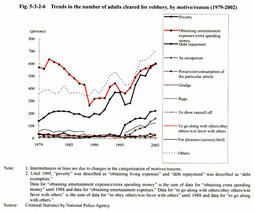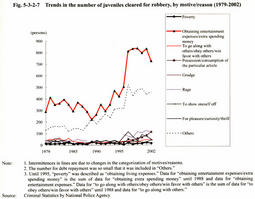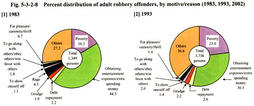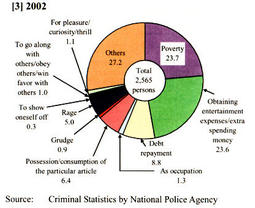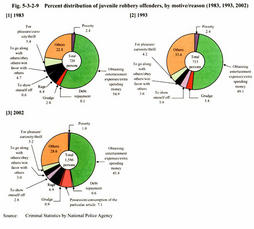| Previous Next Index Image Index Year Selection | |
|
|
3 Characteristics of motives of juvenile robbery offenders -difference from those of adult robbery offenders- As the number of juveniles cleared for homicide is too small as a population parameter for analysis focusing on juvenile offenders' inner motives, it is difficult to conduct objective evaluation of statistical data due to subjective factors. For this reason, this subsection will examine the characteristics of the motives of juvenile offenders focusing on robbery, for which the number of juveniles cleared is large.
Robbery is an offense committed with the intention of taking money or articles or exemption from liabilities, and it is therefore often thought to be committed with a simple motive. However, in reality, robbery is committed with various motives or reasons including serious ones such as poverty and debt load, simplistic ones such as obtaining entertainment expenses or taking particular articles, and special ones such as committing robbery as an occupation. Furthermore, there is a significant gap in motives and reasons between juvenile offenders and adult offenders due to the difference between the two in terms of position in society and mental maturity. In order to identify the causes of the increase in robbery cases, it is necessary to examine these motives and reasons. Fig. 5-3-2-6 and Fig. 5-3-2-7 show the trends in the number of adults and juveniles cleared for robbery since 1979, by motive/reason, and Fig. 5-3-2-8 and Fig. 5-3-2-9 show the percent distribution of adults and juveniles cleared for robbery in 1983, 1993, and 2002, by motive/reason. Among adult offenders, poverty (obtaining living expenses) and obtaining entertainment expenses/extra spending money (sum of data for "obtaining extra spending money" until 1988 and data for "obtaining entertainment expenses"; hereinafter the same in this subsection) have been the two most common motives/reasons, followed by debt repayment, possession/consumption of the particular article (acquiring the particular article), and rage. The number of adult offenders who committed robbery with the motive of obtaining entertainment expenses/extra spending money dropped sharply after peaking in 1981 but turned up again in 1990, and it has been showing an intensified upward trend since 1997. On the other hand, the number of those who committed robbery due to poverty (with the motive of obtaining living expenses) remained flat at a relatively low level during the period of economic boom from 1975 to 1988 but turned up in 1990. It started to rise sharply in 1998 and increased 2.1-fold from 1997 to 2002, reaching a level that is almost the same as the number of those who committed robbery with the motive of obtaining entertainment expenses/extra spending money. The number of those who committed robbery with the exclusive motive of debt repayment remained flat at a low level until 1995 but then rose sharply, increasing 10.2-fold from 1995 to 2002. According to the percent distribution focusing on three years, 1983, 1993, and 2002, the percentage for poverty has been increasing gradually from 16.3% to 23.0% and 23.7%, whereas the percentage for the motive of obtaining entertainment expenses/extra spending money has been decreasing from 44.3% to 30.5% and 23.6%. The percentage for debt repayment has recently been increasing from 2.2% to 2.6% and 8.8%. Among juvenile offenders, the numbers of those who committed robbery due to poverty (with the motive of obtaining living expenses) and for debt repayment have been extremely small because juveniles are not responsible for earning living expenses to maintain their families. Those who committed robbery with the motive of obtaining entertainment expenses/extra spending money have been accounting for the majority, and other common motives/reasons have been possession/consumption of the particular article, rage, and pleasure/curiosity/thrill, for which the number of juveniles who committed robbery has been small. The number of those who committed robbery for obtaining entertainment expenses/extra spending money remained flat or declined from 1975 to 1993 but then turned up, increasing 2.1-fold from 1993 to 2002. According to the percent distribution focusing on three years, 1983, 1993, and 2002, the percentage for the motive of obtaining entertainment expenses/extra spending money has been accounting for about half, at 54.9%, 49.1%, and 45.8%, respectively, which indicates that about half of robbery cases by juveniles, which have been increasing rapidly in recent years, are being committed with the motive of obtaining entertainment expenses/extra spending money as in the past. These statistical data suggest that juveniles commit robbery, a serious offense, with motives as simplistic as obtaining entertainment expenses/extra spending money, because they are not so mentally mature as adults and their consciousness of norms is not so strong. Fig. 5-3-2-6 Trends in the number of adults cleared for robbery, by motive/reason (1979-2002) Fig. 5-3-2-7 Trends in the number of juveniles cleared for robbery, by motive/reason (1979-2002) Fig. 5-3-2-8 Percent distribution of adult robbery offenders, by motive/reason (1983, 1993, 2002) Fig. 5-3-2-9 Percent distribution of juvenile robbery offenders, by motive/reason (1983, 1993, 2002) |
